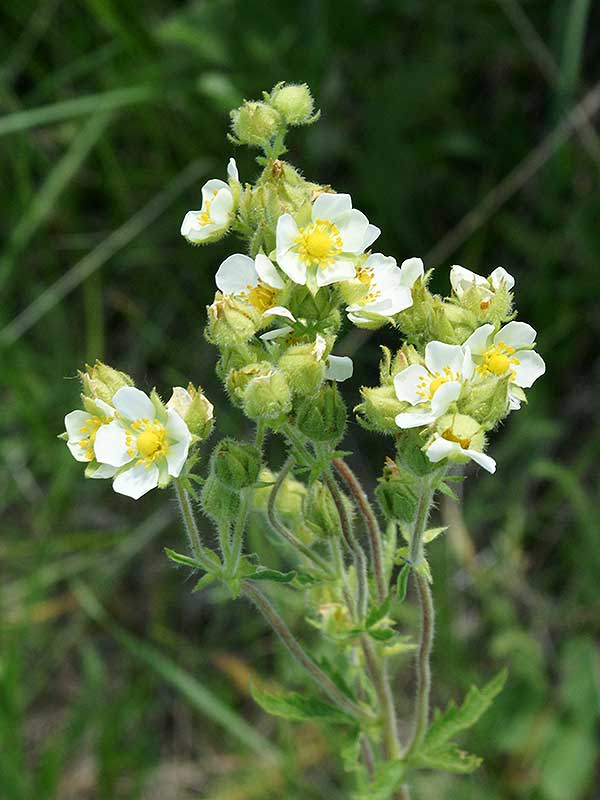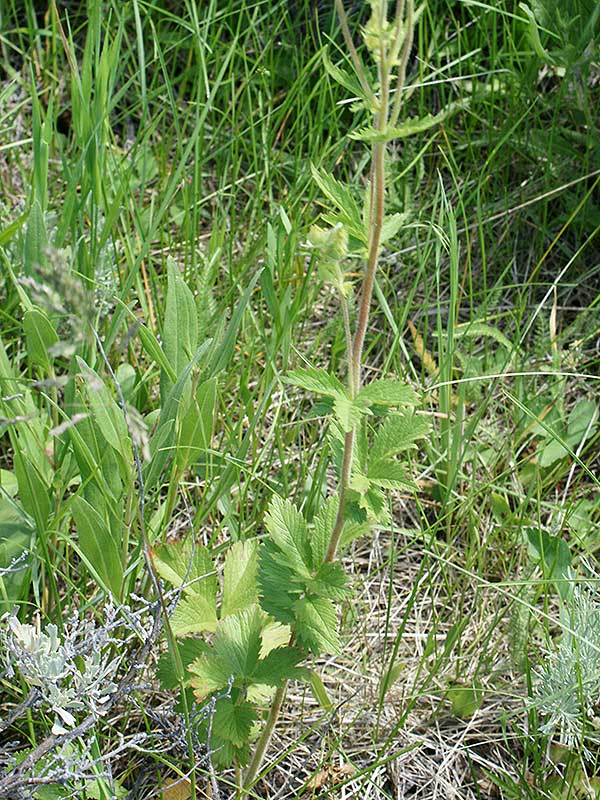Drymocallis glandulosa / sticky cinquefoil
- deeply lobed (almost compound) leaves (3-5 lobes)
- clusters of cream or white 5-petaled flowers
- pointy green sepals visible between non-overlapping petals
- ≥25 stamens
- sticky stems, involucres and buds (glandular hairs)
Also known as: cliff drymocallis, common woodbeauty
Synonyms: Potentilla glandulosa, Drymocallis pseudorupestris
See also: Drymocallis arguta / tall cinquefoil
Drymocallis glandulosa is (usually) a low-growing cinquefoil, most noted for its sticky, glandular hairs on the stems and buds. It is often problematic to differentiate between this species and some similar ones, including Drymocallis arguta (tall cinquefoil). In general, however, the petals of this species are said to be paler than many similar species. Good luck.
Sticky cinquefoil petal are white or creamy but yellow at the bases. Those can be hard to see, however, because of the many (i.e. 25-40) stamens that overtop them. Below them are 5 pointy green sepals. The petals themselves are non-overlapping and may be round to obovate. By comparison with some other species of Drymocallis, those of D. glandulosa open wide.
The flowers grow in loose clusters with hairy, leaf-like bracts (involucres). Technically, the inflorescence has been called a “cyme-like array”, meaning each has its own separate stalk and they mature from the base outwards. By comparison with D. arguta, the inflorescence is relatively open.
D. glandulosa has leaves divided into 2-5 pairs of leaflets or very deep lobes, the end one being largest. They are soft and up to 1.5 inches long, and like the petals, obovate. The leaf margins are single- or double-toothed. Leaf sizes get smaller as they go up the flowering stems. Red stems are common.
D. glandulosa grows in open woods, in meadows, on hillsides and in rocky places. It grows from seed or a caudex, and often appears early in succession after a fire (i.e. it is a “fire follower”).
Finally, while I have identified the photos in the gallery as D. glandulosa, and called them sticky cinquefoil, the common name is not unique to the species. Moreover, species identification of Drymocallis and Potentilla (which is a separate genus but one in which this used to be classified) can be difficult because of large and continuous variations in characteristics across their ranges. These variations reflect (at a minimum) localized ecotypes, polyploidy in the genomes, interspecific hybridization and apomixis.
Interesting bits – Like other sticky plants (e.g. the sticky geranium), sticky cinquefoil is suspected of being protocarnivorous, i.e. sort of prepared to be a carnivore but not there yet. Indeed, it looks like the removal of the Drymocallis spp. from the genus, Potentilla was based on this suspicion.
| Color | |
|---|---|
| Family | |
| Blossom size | |
| Inflorescence size | |
| Inflorescence type | |
| When? | |
| Where? |


